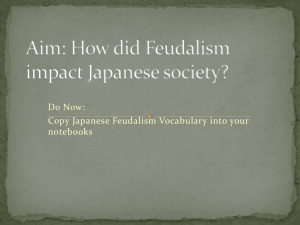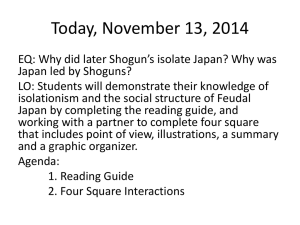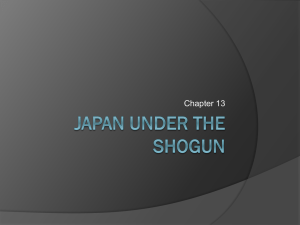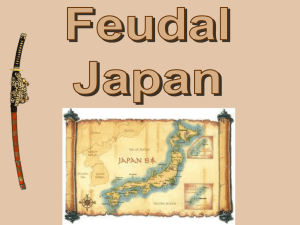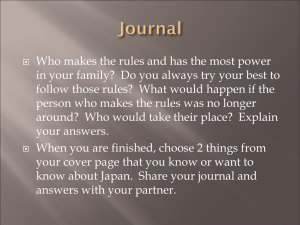Feudalism in Japan - White Plains Public Schools
advertisement
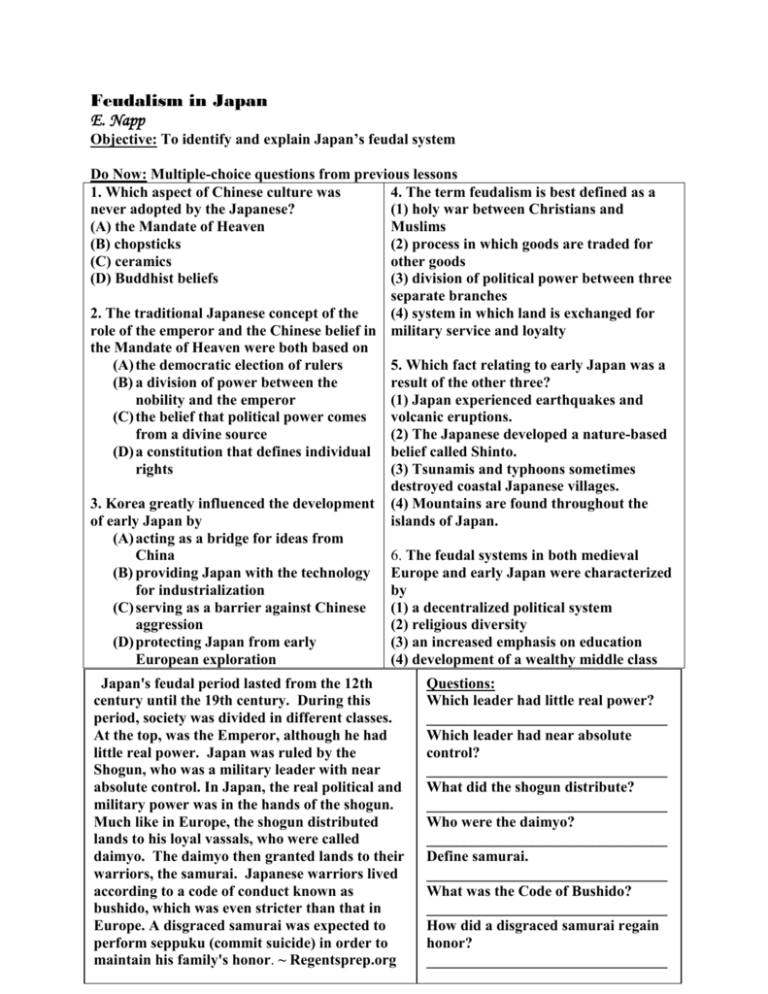
Feudalism in Japan E. Napp Objective: To identify and explain Japan’s feudal system Do Now: Multiple-choice questions from previous lessons 1. Which aspect of Chinese culture was 4. The term feudalism is best defined as a never adopted by the Japanese? (1) holy war between Christians and (A) the Mandate of Heaven Muslims (B) chopsticks (2) process in which goods are traded for (C) ceramics other goods (D) Buddhist beliefs (3) division of political power between three separate branches 2. The traditional Japanese concept of the (4) system in which land is exchanged for role of the emperor and the Chinese belief in military service and loyalty the Mandate of Heaven were both based on (A) the democratic election of rulers 5. Which fact relating to early Japan was a (B) a division of power between the result of the other three? nobility and the emperor (1) Japan experienced earthquakes and (C) the belief that political power comes volcanic eruptions. from a divine source (2) The Japanese developed a nature-based (D) a constitution that defines individual belief called Shinto. rights (3) Tsunamis and typhoons sometimes destroyed coastal Japanese villages. 3. Korea greatly influenced the development (4) Mountains are found throughout the of early Japan by islands of Japan. (A) acting as a bridge for ideas from 6. The feudal systems in both medieval China (B) providing Japan with the technology Europe and early Japan were characterized for industrialization by (C) serving as a barrier against Chinese (1) a decentralized political system aggression (2) religious diversity (D) protecting Japan from early (3) an increased emphasis on education European exploration (4) development of a wealthy middle class Japan's feudal period lasted from the 12th century until the 19th century. During this period, society was divided in different classes. At the top, was the Emperor, although he had little real power. Japan was ruled by the Shogun, who was a military leader with near absolute control. In Japan, the real political and military power was in the hands of the shogun. Much like in Europe, the shogun distributed lands to his loyal vassals, who were called daimyo. The daimyo then granted lands to their warriors, the samurai. Japanese warriors lived according to a code of conduct known as bushido, which was even stricter than that in Europe. A disgraced samurai was expected to perform seppuku (commit suicide) in order to maintain his family's honor. ~ Regentsprep.org Questions: Which leader had little real power? ________________________________ Which leader had near absolute control? ________________________________ What did the shogun distribute? ________________________________ Who were the daimyo? ________________________________ Define samurai. ________________________________ What was the Code of Bushido? ________________________________ How did a disgraced samurai regain honor? ________________________________ Cornell Notes Outline: The Rise of Feudalism in Japan (Add Key Words and Summaries) The Key Words: The Notes: I. Feudalism in Japan A. By the 1100s, the Japanese emperor was weak B. Lords no longer obeyed the emperor 1- They did not pay taxes C. A system of feudalism developed 1- Land was exchanged for military service D. The most powerful lord became the Shogun 1- A Shogun was a military dictator 2- Lords had to obey the Shogun E. The lords of Japan were called Daimyo 1- Daimyo owned land and armies 2- Daimyo were loyal to the Shogun F. The warriors of feudal Japan were samurai 1- Samurai were skilled warriors 2- Samurai followed the Code of Bushido a) The Code of Bushido was a set of rules for samurai 1. 2. 3. The Summaries: A samurai had to be loyal A samurai had to show no emotion The only way for a samurai to regain lost honor was to commit suicide Please read the passage below and answer the questions: The emperor was an important political and religious figure in Japan. However, by the 1100s, the emperor’s power was so weakened that Japan collapsed into civil war. Unable to control the lords of Japan, the emperor lost his political power. A system of feudalism arose in Japan that was similar to feudalism in Western Europe. Lords and their private armies became very powerful. By 1192, Japan’s most powerful lord or noble had the emperor appoint him as Japan’s “Supreme Military Governor” or Shogun. For the next 600 years, the Shoguns were the real rulers of Japan, while the emperors acted as mere figureheads. The Shogun stood at the top of the Japanese feudal system. He was the most powerful lord in Japan. The Shogun was a military dictator. Questions: 1- What happened to the emperor of Japan in the 1100s? ________________________________________________________________________ 2- What arose in Japan in the 1100s? ________________________________________________________________________ 3- Define Feudalism. ________________________________________________________________________ 4- Who was the Shogun? ________________________________________________________________________ 5- Why did the Shogun rule Japan? ________________________________________________________________________ The highest nobles next to the shogun were the daimyos. A daimyo was a noble landowner or a lord. Daimyo controlled larges estates, or pieces of land. Daimyo also had private armies or armies of warriors fought for the daimyo. The daimyo gave land to warriors or samurai, which means “one who serves” in exchange for loyalty and protection. Samurai were warriors on horseback and fearless soldiers who carried swords. They believed that to die in battle was an honor. Samurai practiced the Code of Bushido. The Code of Bushido was the samurai’s code of honor. The Code of Bushido demanded that a samurai be loyal to his lord and brave. A samurai had to obey orders and practice self-discipline, or control over one’s feelings and actions. Honor was the most important thing in his life. If a samurai lost his honor, he had to commit seppuku or hari-kari. He had to kill himself with his own sword. The Japanese believed that seppuku restored or brought back honor. 6- Define daimyo. ________________________________________________________________________ 7- Who were the samurai? ________________________________________________________________________ 8- Describe the relationship between a samurai and his daimyo. ________________________________________________________________________ 9- What was the Code of Bushido? ________________________________________________________________________ 10- How could a samurai regain his honor? ________________________________________________________________________ 11- Compare and contrast European and Japanese Feudalism. ________________________________________________________________________ Word Bank: Archipelago Daimyo Emperor Fixed Knights Spirits Natural Resources Irregular Mountains Seppuku Kami Samurai Shogun Shintoism Caste Bushido Feudalism The code of bushido of the Japanese samurai is most similar to (A) belief in reincarnation and karma of Hindus (B) practice of chivalry by European knights (C) teachings of Judaism (D) theory of natural rights of the Enlightenment writers Which is a characteristic of a feudal society? (A) rapid social change (B) high literacy rate (C) industrial-based economy (D) rigid class structure


